最新八年级英语下册 Unit 1 What's the matter The First Period (Section A 1a-2d)教案
人教版初二(下)英语unit1 what's the matter知识点讲解与练习
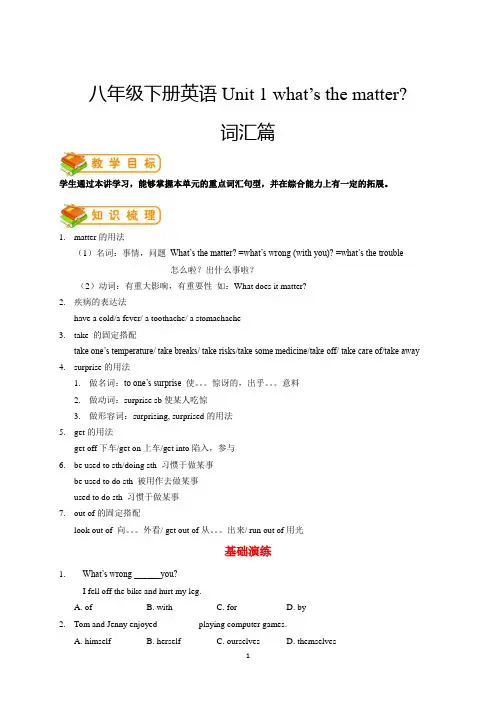
八年级下册英语Unit 1 what’s the matter?词汇篇学生通过本讲学习,能够掌握本单元的重点词汇句型,并在综合能力上有一定的拓展。
1.matter的用法(1)名词:事情,问题What’s the matter? =what’s wrong (with you)? =what’s the trouble怎么啦?出什么事啦?(2)动词:有重大影响,有重要性如:What does it matter?2.疾病的表达法have a cold/a fever/ a toothache/ a stomachache3.take 的固定搭配take one’s temperature/ take breaks/ take risks/take some medicine/take off/ take care of/take away 4.surprise的用法1.做名词:to one’s surprise 使。
惊讶的,出乎。
意料2.做动词:surprise sb使某人吃惊3.做形容词:surprising, surprised的用法5.get的用法get off下车/get on上车/get into陷入,参与6.be used to sth/doing sth 习惯于做某事be used to do sth 被用作去做某事used to do sth 习惯于做某事7.out of的固定搭配look out of 向。
外看/ get out of从。
出来/ run out of用光基础演练1.---What’s wrong ______you?---I fell off the bike and hurt my leg.A. ofB. withC. forD. by2.Tom and Jenny enjoyed _________playing computer games.A. himselfB. herselfC. ourselvesD. themselves3. Sally became interested ___________science and wanted to be a scientist.A. forB. inC. throughD. at4. ---I had a __________.---You’d better go to see a dentist.A. headacheB. feverC. coldD. toothache5. I didn’t _________my temperature, but I knew I had a fever.A. giveB. setC. takeD. show二、根据汉语意思翻译句子。
人教版八年级英语下册 Unit 1 What’s the matter?知识点复习
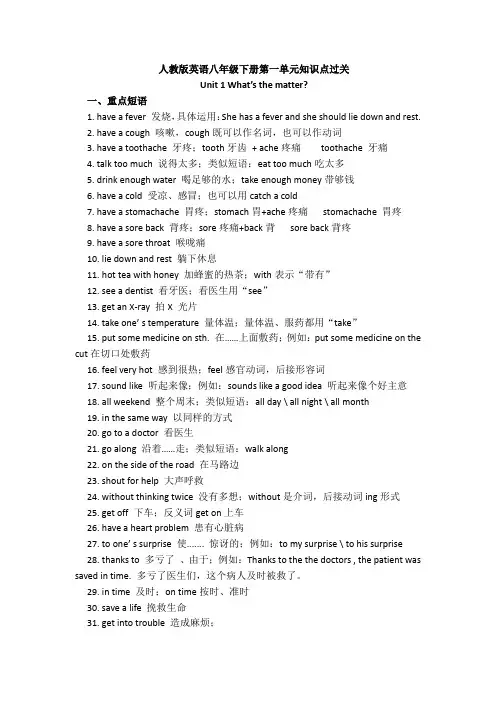
人教版英语八年级下册第一单元知识点过关Unit 1 What’s the matter?一、重点短语1. have a fever 发烧,具体运用:She has a fever and she should lie down and rest.2. have a cough 咳嗽,cough既可以作名词,也可以作动词3. have a toothache 牙疼;tooth牙齿+ ache疼痛toothache 牙痛4. talk too much 说得太多;类似短语:eat too much吃太多5. drink enough water 喝足够的水;take enough money带够钱6. have a cold 受凉、感冒;也可以用catch a cold7. have a stomachache 胃疼;stomach胃+ache疼痛stomachache 胃疼8. have a sore back 背疼;sore疼痛+back背sore back背疼9. have a sore throat 喉咙痛10. lie down and rest 躺下休息11. hot tea with honey 加蜂蜜的热茶;with表示“带有”12. see a dentist 看牙医;看医生用“see”13. get an X-ray 拍X 光片14. take one’ s temperature 量体温;量体温、服药都用“take”15. put some medicine on sth. 在……上面敷药;例如:put some medicine on the cut在切口处敷药16. feel very hot 感到很热;feel感官动词,后接形容词17. sound like 听起来像;例如:sounds like a good idea 听起来像个好主意18. all weekend 整个周末;类似短语:all day \ all night \ all month19. in the same way 以同样的方式20. go to a doctor 看医生21. go along 沿着……走;类似短语:walk along22. on the side of the road 在马路边23. shout for help 大声呼救24. without thinking twice 没有多想;without是介词,后接动词ing形式25. get off 下车;反义词get on上车26. have a heart problem 患有心脏病27. to one’ s surprise 使....... 惊讶的;例如:to my surprise \ to his surprise28. thanks to 多亏了、由于;例如:Thanks to the the doctors , the patient was saved in time. 多亏了医生们,这个病人及时被救了。
人教版英语八年级下册Unit1《What’sthematter》说课稿
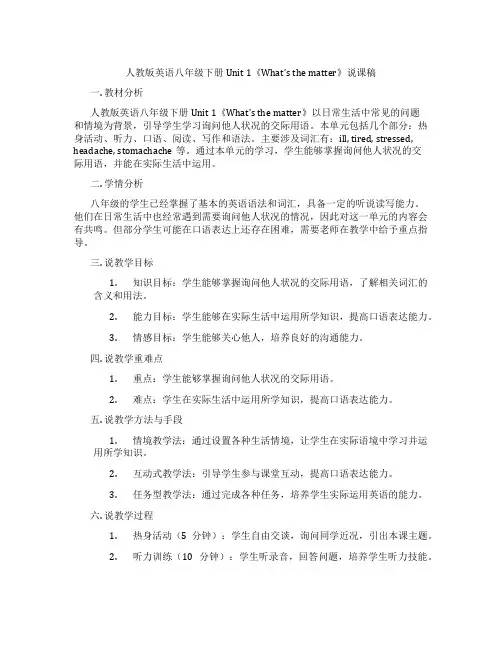
人教版英语八年级下册Unit 1《What’s the matter》说课稿一. 教材分析人教版英语八年级下册Unit 1《What’s the matter》以日常生活中常见的问题和情境为背景,引导学生学习询问他人状况的交际用语。
本单元包括几个部分:热身活动、听力、口语、阅读、写作和语法。
主要涉及词汇有:ill, tired, stressed, headache, stomachache等。
通过本单元的学习,学生能够掌握询问他人状况的交际用语,并能在实际生活中运用。
二. 学情分析八年级的学生已经掌握了基本的英语语法和词汇,具备一定的听说读写能力。
他们在日常生活中也经常遇到需要询问他人状况的情况,因此对这一单元的内容会有共鸣。
但部分学生可能在口语表达上还存在困难,需要老师在教学中给予重点指导。
三. 说教学目标1.知识目标:学生能够掌握询问他人状况的交际用语,了解相关词汇的含义和用法。
2.能力目标:学生能够在实际生活中运用所学知识,提高口语表达能力。
3.情感目标:学生能够关心他人,培养良好的沟通能力。
四. 说教学重难点1.重点:学生能够掌握询问他人状况的交际用语。
2.难点:学生在实际生活中运用所学知识,提高口语表达能力。
五. 说教学方法与手段1.情境教学法:通过设置各种生活情境,让学生在实际语境中学习并运用所学知识。
2.互动式教学法:引导学生参与课堂互动,提高口语表达能力。
3.任务型教学法:通过完成各种任务,培养学生实际运用英语的能力。
六. 说教学过程1.热身活动(5分钟):学生自由交谈,询问同学近况,引出本课主题。
2.听力训练(10分钟):学生听录音,回答问题,培养学生听力技能。
3.口语交流(10分钟):学生分组讨论,模拟生活情境,练习询问他人状况的交际用语。
4.阅读理解(15分钟):学生阅读课文,回答问题,巩固所学知识。
5.写作练习(10分钟):学生根据题目,写一篇关于询问他人状况的文章。
6.语法讲解(10分钟):老师讲解语法知识点,帮助学生巩固。
新目标英语八年级下Unit 1What's the matter?句子翻译 (2)
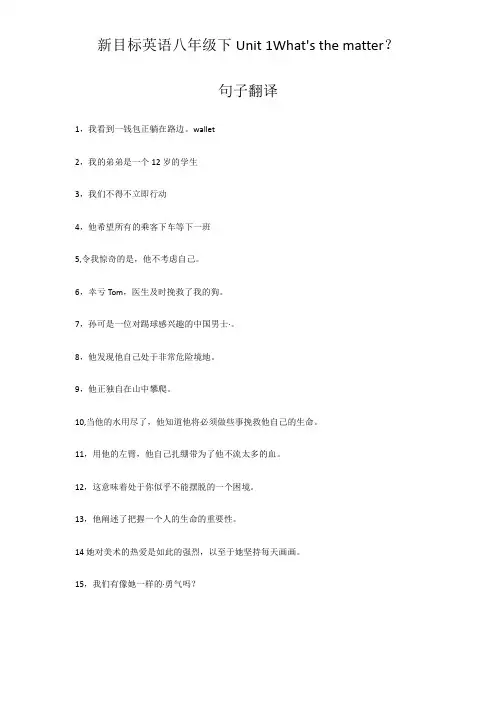
新目标英语八年级下Unit 1What's the matter?
句子翻译
1,我看到一钱包正躺在路边。
wallet
2,我的弟弟是一个12岁的学生
3,我们不得不立即行动
4,他希望所有的乘客下车等下一班
5,令我惊奇的是,他不考虑自己。
6,幸亏Tom,医生及时挽救了我的狗。
7,孙可是一位对踢球感兴趣的中国男士·。
8,他发现他自己处于非常危险境地。
9,他正独自在山中攀爬。
10,当他的水用尽了,他知道他将必须做些事挽救他自己的生命。
11,用他的左臂,他自己扎绷带为了他不流太多的血。
12,这意味着处于你似乎不能摆脱的一个困境。
13,他阐述了把握一个人的生命的重要性。
14她对美术的热爱是如此的强烈,以至于她坚持每天画画。
15,我们有像她一样的·勇气吗?。
人教新目标八年级英语下册Unit 1 What's the matter单词速记
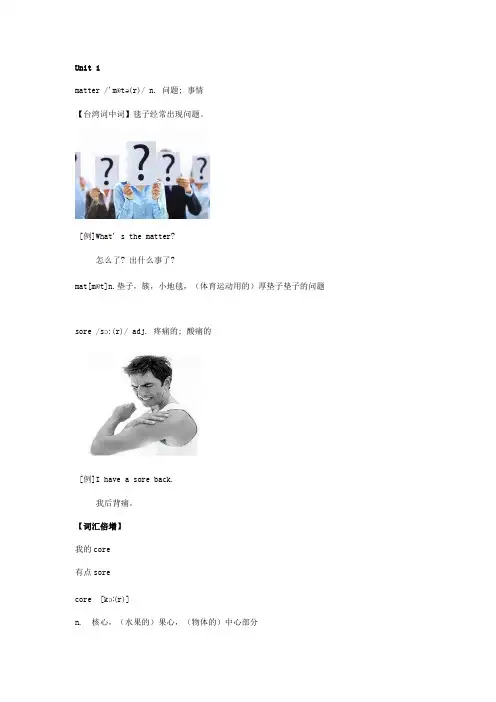
Unit 1matter /'mætə(r)/ n. 问题; 事情【台湾词中词】毯子经常出现问题。
[例]What' s the matter?怎么了? 出什么事了?mat[mæt]n.垫子,簇,小地毯,(体育运动用的)厚垫子垫子的问题sore /sɔ:(r)/ adj. 疼痛的; 酸痛的[例]I have a sore back.我后背痛。
【词汇倍增】我的core有点sorecore [kɔː(r)]n. 核心,(水果的)果心,(物体的)中心部分have a cold 感冒[例]I have a cold.我感冒了。
stomachache /'stʌməkeɪk/ n. 胃痛; 腹痛have a stomachache 胃痛[例]I have a stomachache.我胃痛。
【英国字母索源法】stomach(胃)+ache(痛)foot /fʊt/ n. 脚; 足【英国字母索源法】f代表“五官”[例]One of my feet is dirty.我的一只脚脏了。
neck /nek/ n. 颈; 脖子【英国字母索源法】n代表“细长”[例]The neck of the glass is dirty.杯颈脏了。
stomach /'stʌmək/ n. 胃; 腹部[例]what a stomach he has got !他可真是个大腹便便的人!【脑图单词速记】蛇s吐to马ma吃chthroat /θrəʊt/ n. 咽喉; 喉咙 p.1【英国字母索源法】thr代表“三”throat喉咙--通向三处,Third第三 thirteen十三 thirty三十。
[例]She has a very sore throat now.她现在嗓子疼的很厉害。
【词汇倍增】一只goat(山羊)穿件coat(衣服)上了boat(船)掉进moat(城壕)摔断throat (喉咙)fever /'fi:və/ n. 发烧[例] She has a fever.她发烧了。
初二下册单元英语知识点:Unit1What’sthematter-
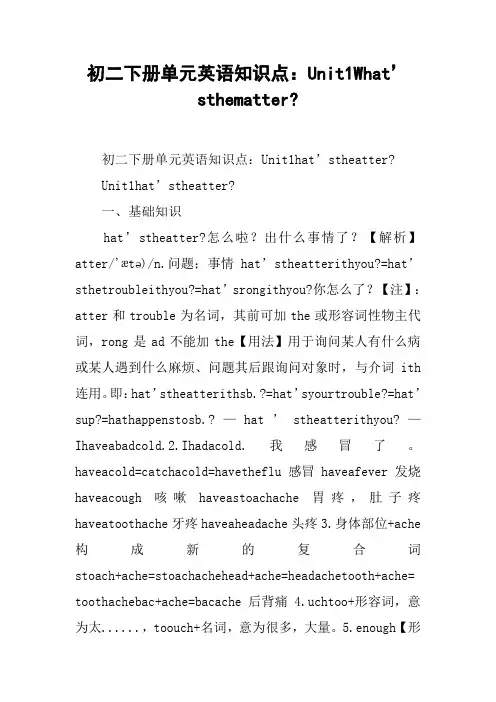
初二下册单元英语知识点:Unit1What’sthematter?初二下册单元英语知识点:Unit1hat’stheatter?Unit1hat’stheatter?一、基础知识hat’stheatter?怎么啦?出什么事情了?【解析】atter/'ætə)/n.问题;事情hat’stheatterithyou?=hat’sthetroubleithyou?=hat’srongithyou?你怎么了?【注】:atter和trouble为名词,其前可加the或形容词性物主代词,rong是ad不能加the【用法】用于询问某人有什么病或某人遇到什么麻烦、问题其后跟询问对象时,与介词ith 连用。
即:hat’stheatterithsb.?=hat’syourtrouble?=hat’sup?=hathappenstosb.?—hat’stheatterithyou?—Ihaveabadcold.2.Ihadacold.我感冒了。
haveacold=catchacold=havetheflu感冒haveafever发烧haveacough咳嗽haveastoachache胃疼,肚子疼haveatoothache牙疼haveaheadache头疼3.身体部位+ache 构成新的复合词stoach+ache=stoachachehead+ache=headachetooth+ache= toothachebac+ache=bacache后背痛4.uchtoo+形容词,意为太......,toouch+名词,意为很多,大量。
5.enough【形容、副词】足够的/地,enough放在名前后,形副后。
goodenough足够好,enoughoney=uchoney6.liedon躺下,lie躺,躺着,过去式lay;lie说谎,过去式lied7.aybe “或许”,常用于句首,表示可能性,后加句子。
Unit 1 What 's the matter 知识点讲解带练习 课件 人教版英语八年级下册
谢谢大家!
三、语法知识
● 1.询问某人的身体状况及遇到麻烦的表达方法 ● What’s the matter (with sb.)?(某人)怎么了? ● What’s wrong (with sb.)? ● What’s the trouble (with sb.)?
●2. 表达身体疼痛或不舒服的句型
● ①某人+have/has+病症/身体部位+ache. ● ②某人+have/has+a+sore+发病部位. ● ③某人+hurt(s)+身体部位或反身代词(oneself). ● ④某部位+hurt(s). ● ⑤There is something wrong with one’s+sb/部位
●
= have difficulty doing
●
= have problems doing
●
●4.反身代词
● 【考点】① 第一人称和第二人称的反身代词 形代+self
●
② 第三人称的但身代词宾格+self
●
③ 常见的搭配
● enjoy oneself=have a good time=have fun玩的开心 ● help yourselves/yourself随便吃;别拘束 ● by oneself= on sb’s own靠某人自己;独立
● (一)单项选择
● 5. The old man is used to __________ tea after he gets up.
● A. drink
B. drinks
C. drinking
D. drank
● 6. Don't forget to take your bag when you________ the bus.
八年级下册英语句式语法总结
八年级下册英语句式语法总结一、Unit 1 What's the matter?1. 重点句式。
- What's the matter (with sb.)? = What's wrong (with sb.)? = What's the trouble (with sb.)? 某人怎么了?例如:What's the matter with you? You look pale.- sb. have/has a + 疾病名称。
如:I have a cold.- sb. should/shouldn't + 动词原形。
表示建议,应该/不应该做某事。
例如:You should drink some hot tea with honey. You shouldn't go to bed late.2. 语法。
- 情态动词should的用法:should没有人称和数的变化,后接动词原形,表示劝告、建议等。
例如:He should see a doctor.二、Unit 2 I'll help to clean up the city parks.1. 重点句式。
- I'd like to do sth. = I want to do sth. 我想要做某事。
例如:I'd like to help homeless people.- give out = hand out 分发。
例如:We'll give out food at the food bank.- come up with = think up 想出。
例如:Can you come up with a good idea?- make a difference (to sb./sth.)(对某人/某事)有影响。
例如:Your help can make a great difference to these children.2. 语法。
人教版八年级英语下册Unit1What’sthematter(16课时)教学设计
2.增强学生的健康意识,使其认识到健康的重要性,养成良好的生活习惯。
3.培养学生积极向上的心态,面对困难和挫折时,能够保持乐观,寻求帮助。
4.通过学习英语,拓宽学生的国际视野,使其了解并尊重不同文化背景下的健康观念。
5.鼓励学生参与课堂活动,增强自信心,培养合作精神。
3.加强词汇教学,通过游戏、竞赛等形式,帮助学生记忆和巩固词汇。
4.设计多样化的听力练习,提高学生的听力水平,培养其英语语感。
5.关注学生的情感态度,引导他们正确面对健康问题,培养积极的心态。
三、教学重难点和教学设想
(一)教学重难点
1.词汇和短语:本章节的重点词汇和短语涉及描述健康问题的各个方面,如身体部位、症状等。这些词汇和短语的掌握对于学生能够流畅地表达和交流至关重要。
3.听力训练:利用课外时间,观看英语原声视频,如健康主题的TED演讲或医生与患者的对话,提高听力水平,并记录下新学到的表达方式。
4.口语作业:与同学组成小组,进行角色扮演,录制一段关于健康问题的对话视频,要求每个成员都有发言机会,并在视频中加入适当的身体语言。
5.写作练习:写一篇关于“如何保持健康生活方式”的短文,至少80词,使用本节课学习的词汇和句型,表达个人观点。
3.学生分享:鼓励学生分享自己在生活中遇到的健康问题及解决方法,激发学生兴趣,为新课学习做好铺垫。
(二)讲授新知
1.教学内容:教师针对本节课的重点词汇、短语和句型进行讲解,如:“What’s the matter?” “I have a toothache/too much homework.” “You should/need to…”等。
八年级下册unit1_what‘s_the_matter课文重难点讲解
Unit 1 What’s the matter?Section A1. What’ s the matter? 怎么啦?出什么事情了?【解析】matter/ ' mætə(r)) /n.问题;事情What’ s the matter with you?= What’s the trouble with you?= What’ s wrong with you?你怎么了?【注】:matter 和trouble 为名词,其前可加the 或形容词性物主代词,wrong 是adj. 不能加the【2013自贡3】18. —What’s the matter ______ Tom. He is wet through.—His car ran _______ the river.A.with; inB.to; intoC.with; into【用法】用于询问某人有什么病或某人遇到什么麻烦、问题其后跟询问对象时,与介词with连用。
即:What’s the matter with sb.?= What’s your trouble?= What’s up?= What happens to sb.?—What’s the matter with you ?—I have a bad cold.( ) ①What’s ____ with you?A. troubleB. the matterC. the wrongD. matter( )②—______?—Nothing serious , but a bit tired.—Better have a rest now, dear.A. Is that allB. Is there anything elseC. What’s thisD. What’s the matter with you【2013湖北孝感】—_________?—I have a headache and I don’t feel like eating anything.A. How are youB. What can I do for youC. What’s the matter with youD. How do you like it【2011.云南昆明】27. —What’s the matter with Tina?—_______________.A. She is away.B. She is cool.C. She has a sore throat.D. She should take some medicine【拓展】matter的用法(1) It doesn’t matter 没关系(用来回答别人道歉时的用语)( ) —I’m sorry to break your pen. —_______A. That’s rightB.It doesn’t matterC. Thank you【2013江苏徐州】3. —Please don't throw paper on the ground.—________,I won't.A. Excuse meB. That's all rightC. SorryD. It doesn't matter【2013黑龙江齐齐哈尔】17.-I have a pain in my back.-_____ . You’d better see a doctor.A. I’m sorry to hear thatB. Nothing seriousC. It doesn’t matter【2013湖北武汉】39. —I’m very sorry. I broke your tea cup.—__________.A. It doesn’t matterB. You’d better notC. Take it easyD. It’s too bad【2013四川广安】26.—Sorry, I'm late again.—______.A.That’s OK B.It doesn't matter C.Good idea (2) as a matter of fact= in fact 事实上, 实际上2. I have a cold 我感冒了I have a stomachache 我患胃痛I have a sore back. 我背痛。
- 1、下载文档前请自行甄别文档内容的完整性,平台不提供额外的编辑、内容补充、找答案等附加服务。
- 2、"仅部分预览"的文档,不可在线预览部分如存在完整性等问题,可反馈申请退款(可完整预览的文档不适用该条件!)。
- 3、如文档侵犯您的权益,请联系客服反馈,我们会尽快为您处理(人工客服工作时间:9:00-18:30)。
The First Period (Section A 1a-2d)Teaching Aims1. Knowledge Objects(1) Function: ①Learn to describe and talk about the health problems and accidents.②Learn to give others some right advice according to their problems.(2)Key Vocabulary: matter, sore, throat, stomachache, foot, neck, stomach, fever, lie, rest, cough, toothache, headache, have a sore back, have a stomachache, have a cold, lie down, see a dentist, get an X-ray, take on e’s temperature, have a fever, have a headache, take breaks, in the same way, go to a doctor(3)Target Language:①What’s the matter? I have a stomachache./ I have a sore back. / I have a cold.②She has a very sore throat. ③My head feels very hot.④What should I do?⑤I think you should lie down and rst.(4)Structure:①have a+ the names of the illness②should+verb2. Ability ObjectsEnable students to talk about health problems and give advice with the language points.3. Moral Objects(1)Improve the cooperative spirit through pair work and role playing.(2)Students care more about themselves and their family members’ health.Teaching Key Points1. Learn and master the parts of the body, the names of the illness and the expressions of giving advice.2. Learn to talk about health problems by using “What’s the matter? I have a…” and give advice by using “should”.Teaching Difficult Points1. Learn to talk about health problems by using “What’s the matter? I have a…”.2. Learn to give appropriate advice to the certain health problems.Teaching MethodsTask-based language teaching method, the cooperative learning method, and multimedia-assisted teaching and learning method.Teaching AidsThe picture about illness; PPT.Teaching ProceduresStep 1 Warming-up (about 2 minutes)Sing the English song If you’re happy.Step 2 Presentation (about 6 minutes)T: This is really a beautiful song. What can you do if you are happy?Ss: Clap our hands and stamp our feet.T: Yes. Hands and feet are parts of our body; do you know other parts of our body in English? Ss: Eye, head…T: You’re great. Today, let’s learn the names of thee body parts.The teacher touches the parts of the body one by one and says them. While teaching each one, let students touch or show it.Present a picture of Pan Changjiang on the screen. Let students say each part of the body.Work on Section A 1a.Play the game: Touch the parts of your body. Let the whole class touch the parts of their body when teacher say: Touch your…Ask eight students to come to the front and do as the teacher tells them: Touch your…If one does wrong, let him or her go back, the last one who’s in the front is the winner.Step 3 Presentation and Practice (about 8 minutes)The teacher mimes having a stomachache with an action of touching his stomach, and asks, “What’s the matter?”(Write it on the blackboard), then says, “I’m not feeling well, I have a stomachache.” (Students repeat with teacher.)Then show some pictures on the screen and ask students to practice.Have students look at the picture and ask: What can we say to him?Ss: What’s the matter?T: Yes. And what should the boy say?Ss: I have a stomachache.Let students repeat with other pictures about other illness.Ask some students to use gestures to show the illness, and have others to guess.Make a model dialogue. (S1 does an action to express an illness.)T: What’s the matter?Ss: He/ She has a headache.Let students practice other illness.A: What’s the matter?B: He/ She has a headache/ toothache/ a sore back/ a sore throat/ a cold and a cough. Show other pictures, and ask students to talk about health problems of the persons in the pictures in pairs.Step 4 Listen and Say (about 8 minutes)Work on Section A 1b, listen and number the names [1-5].Have students look at the picture and read 1c, and tell students that the girl talked too much yesterday and she has a very sore throat now. Then ask them look at the picture, practice saying other problems. For example: The boy eats too much ice cream and has a stomachache.Have students work in pairs according to 1c and ask some pairs to act out their conversations.Step 5 Presentation (about 5 minutes)Teacher pretends to cough and asks:T: What’s the matter with me?Ss: Do you have a cough/ a sore throat?T: Yes, I have a sore throat. Can you give me some advice? What should I do?Ss: You should drink hot tea with honey/ shouldn’t talk too much/ go to a doctor…(Students can give different advice as they like)Show different pictures to students, have them practice in pairs.S1: What’s the matter with him/ her?S2: Yes, he/ she has a/ an toothache/ fever/ headache…(Teach the new words)What should he/ she do?S2: He/ She should go to see a dentist/ lie down and rest/ drink a lot of water./ see a doctor… He/ She shouldn’t drink cold water/ play basketball…Work in groups, and have students role-play between a doctor and a patient. Ask them to talk about the health problems and give advice in groups.Step 6 Practice (about 7 minutes)Do 2a. Have students listen and number the picture [1-5]in the order they hear. Then check the answer.Play the tape again for the students and let them do 2b by themselves.Have students listen again and match the problems with the advice. Then play it again and check the answers.Do 2c. Pair work. Let students read the conversations in 2c first. Then work in pairs, make a new conversation according to 2a and 2b. For example:A: What’s the matter?B: My back feels terrible.A: Maybe you have headache. You should see a doctor and get an X-ray.B: That’s a good idea.Show more pictures and let students make more conversations.Step 7 Expansion and Extension (about 5 minutes)Role-play the conversation.First, have students to role-play the conversation in 2d in groups and choose the best. In groups, students discuss the language points and solve the problems. The teacher walks around and gives them some help if they need.Work in groups. Have students do a survey in groups about their health problems, then discuss in groups and give some right advice and make a new conversation.Ask each group to report their conversations.Step 8 Summary (about 3 minutes)Ask students to sum up the parts of a body and the names of illness.Help students to sum up how to give advice by using “should”and “shouldn’t”, then ask them to give the right advice about different problems.Step 9 Homework (about 1 minute)Give advice to the following problems as much as possible: sore throat, toothache, headache, cold. Then choose one to make a dialogue with your partner.Search on the internet about more advice of different health problems and accidents. Blackboard DesignUnit 1 What’s the matter?The First Period (Section A 1a-2d)What’s the matter? I have a stomachache/ sore throat/ a cold.She/ He has a very sore throat.My head feels very hot.What should I/he/she do? You should/ shouldn’t…第一课时作业设计一、根据句意、汉语意思和首字母提示完成句子。
